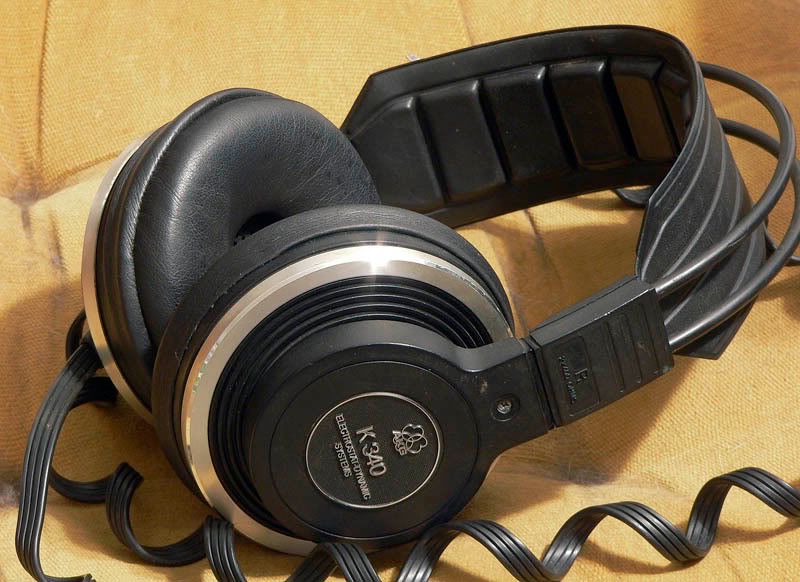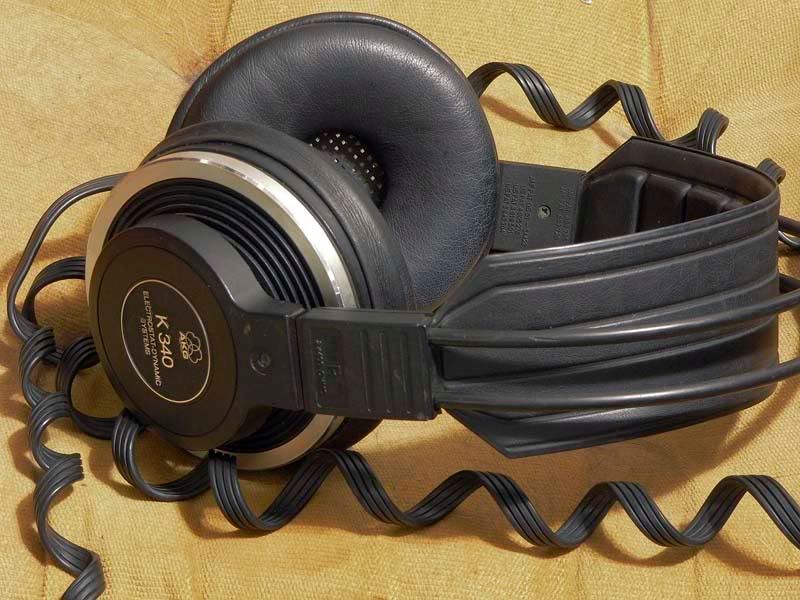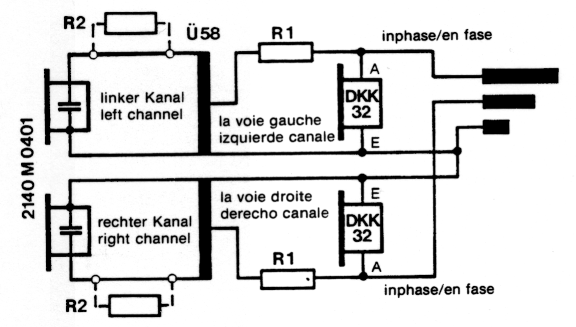wualta
Orthodynamic Supremus
- Joined
- Sep 12, 2004
- Posts
- 4,596
- Likes
- 146
Yes, it's hard to believe, but I found a K340 for a decent price, and it's still undergoing the normal descaling and steam cleaning processes old studio 'phones have to go through here at The Lab, but I did do some preliminary tests and took some photos so all the aficionados can tell me when they think this pair was made and what sort of mods will be suitable. It's apparently the bass-normal version, because without EQ both ends sound rolled off, though the mids are flat. No "AKG" logo on the headband.
The earpads were dirty enough to require a couple of cycles in the washing machine. While those dry out and get the leather-restorative treatment, an old set of Sony replacement earpads that were sold to me years ago by a dealer suspiciously eager to convince me they were the exact replacements for my Sony ECR-500's pads are filling in. Very comfy, though they force the ear away from the diaphragm and are responsible for some of the bass-normal sound. Inside, the electrets appear to be unprotected from hairs, dust and moisture! Mine required a good vacuuming. Channel balance is perfect. Passive diaphragms are ivory colored and backed by gray damping screens.
I've always thought the passives were a way of acoustically "unsealing" a closed-back headphone-- using resonant diaphragms like ports in a bandpass enclosure to vent some frequencies to the atmosphere and gaining the low natural resonant frequency of an open 'phone while retaining the seal of a closed 'phone, and I don't think I was far wrong. But the passives are just diaphragms, not "drivers". They don't produce sound. The passives don't "form the crossover" either. They perform the same function as the vents in the K501-- they let certain frequencies from the backwave of the dynamic ( = bass + midrange) driver get into the earcup. Each diaphragm is tuned to a different frequency and is damped by the plastic screen behind it (and the cotton). The idea is to let controlled amounts of antiphase midrange frequencies enhance the spatial abilities of the 'phone without cancelling the bass, a really neat idea, though undoubtedly expensive. Call it Tuned Leakage.
Back to the 'phones at hand: The elastics in this sample are game but tired. Is there a way to increase the tension, or must they be replaced? [Editor's Note: Oh tsk tsk. Wualta (and any interested modsters) should consult KT88's compilation of the major K340 mods. If it'd been a snake, it woulda bit him; it's right here.]
I see why people cut out the plastic earcup grille, because as you can see in the second photo, the holes in the grille only randomly align with the holes in the electret driver. For high frequencies, this isn't that much of a problem, and the electret badly needs protection. You should've seen the crud I vacuumed out of mine. But still... something like window screening would be better.


Has anyone traced out the circuit on the little "crossover" circuit board? EDIT: It's not a crossover. Not in the usual sense... turns out...

...the original K340 brochures were correct. This simple circuit controls the level of the electret versus the dynamic driver. There is no filter network to "bypass". Both drivers operate wide open, so to speak.
.
The earpads were dirty enough to require a couple of cycles in the washing machine. While those dry out and get the leather-restorative treatment, an old set of Sony replacement earpads that were sold to me years ago by a dealer suspiciously eager to convince me they were the exact replacements for my Sony ECR-500's pads are filling in. Very comfy, though they force the ear away from the diaphragm and are responsible for some of the bass-normal sound. Inside, the electrets appear to be unprotected from hairs, dust and moisture! Mine required a good vacuuming. Channel balance is perfect. Passive diaphragms are ivory colored and backed by gray damping screens.
I've always thought the passives were a way of acoustically "unsealing" a closed-back headphone-- using resonant diaphragms like ports in a bandpass enclosure to vent some frequencies to the atmosphere and gaining the low natural resonant frequency of an open 'phone while retaining the seal of a closed 'phone, and I don't think I was far wrong. But the passives are just diaphragms, not "drivers". They don't produce sound. The passives don't "form the crossover" either. They perform the same function as the vents in the K501-- they let certain frequencies from the backwave of the dynamic ( = bass + midrange) driver get into the earcup. Each diaphragm is tuned to a different frequency and is damped by the plastic screen behind it (and the cotton). The idea is to let controlled amounts of antiphase midrange frequencies enhance the spatial abilities of the 'phone without cancelling the bass, a really neat idea, though undoubtedly expensive. Call it Tuned Leakage.
Back to the 'phones at hand: The elastics in this sample are game but tired. Is there a way to increase the tension, or must they be replaced? [Editor's Note: Oh tsk tsk. Wualta (and any interested modsters) should consult KT88's compilation of the major K340 mods. If it'd been a snake, it woulda bit him; it's right here.]
I see why people cut out the plastic earcup grille, because as you can see in the second photo, the holes in the grille only randomly align with the holes in the electret driver. For high frequencies, this isn't that much of a problem, and the electret badly needs protection. You should've seen the crud I vacuumed out of mine. But still... something like window screening would be better.


Has anyone traced out the circuit on the little "crossover" circuit board? EDIT: It's not a crossover. Not in the usual sense... turns out...

...the original K340 brochures were correct. This simple circuit controls the level of the electret versus the dynamic driver. There is no filter network to "bypass". Both drivers operate wide open, so to speak.
.




